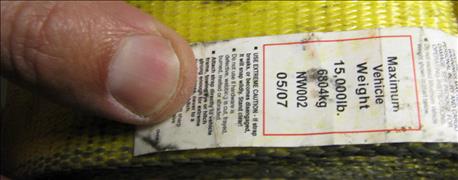
We just left a friend’s house with 50 small square bales of grass hay stacked in the bed of a Ford F-150 pickup. The friend I bought the hay from insists he’s an expert stacker, and there is no need to strap down the load. I give in, partly because I really didn’t have the right equipment to secure the load anyway.
We pull onto a four-lane, divided U.S. highway. My son is driving. There’s a gradual incline on a slight curve. It seems like he’s getting above the 35 miles per hour I suggested.
We hear a noise and look back in horror. The wind just lifted off the back third of the load and scattered bales all over the highway. All I can see is a red sports car barreling up toward us, with a 50-pound hay bale directly in his path. Fortunately, he swerved and dodged it without losing control. My heart skipped a beat- maybe a couple.

CHECK RATING AND CONDITION- Before you use straps to secure loads, check ratings and condition of the strap. This is actually a strap designed for towing. (Photo courtesy Fred Whotford)
If you need more incentive than that story to secure anything you haul- hay bales, bags of seed- you name it, maybe you don’t need to be hauling it. At least that’s the recommendation Fred Whitford made when I asked him what I should do next time!
Whitford is director of Purdue University Pesticide Programs. Since things farmers haul include pesticides, often in plastic tanks, he put together a publication explaining how loads should be secured. But he included plenty of pictures of both doing it wrong and doing it right. Check out PPP-75, ‘Securing the load.’ Ask your Extension educator about it.
What follows is background information about some of the nitty-gritty details you need to know to avoid predicaments. It shouldn’t take you long to conclude that all chains and all tow straps aren’t created qual. Cheaper isn’t always better. Equipment used to secure loads should meet specific standards.
Working Load Limit- referred to in the industry as WLL, this is the maximum weight of cargo, whatever it is, that a tie-down can handle. If you’re purchasing an assemble web strap, look for the WLL before you buy. It should be imprinted on a tag sewn near the end of the strap. If you add up the WLL numbers for all the tie-downs securing a load, it must equal at least half the weight of the secured cargo.
How many tie-downs do you need? Suppose you’re hauling something like a tractor or implement on a trailer. The question that arises is how many tie-downs are needed. Don’t leave it to chance. There are strict guidelines as to how many tie-downs are required.
Use one tie-down for objects five-feet long or less, and weighing 1,100 pounds or less. About the only tractor that might qualify here would be a garden tractor.
Both length and weight of cargo matters- Suppose you’re hauling something that is five feet or less, but it is much heavier than a garden tractor. It weighs more than 1,100 pounds. Then rules say you need two tie-downs to secure it. If the load is longer than five feet but 10 feet or less, perhaps a small antique tractor, use two tie-downs. For articles longer than 10 feet, use one tie-down for every 10 liner feet or fraction thereof. Maybe you’re hauling boards or plastic pipe, for example.
When to no longer use a damaged web strap- One thing Whitford found when he looked in the back of farmer pickups were chains or straps with damage. There are set guidelines for when you should remove a damaged web strap from service. In other words, throw it away and buy a new one.
If the strap is 2 inches wide or less and the damage is larger than 3/8ths of an inch, don’t use the strap. If the strap is three inches wide and the damage is larger than 5/8ths of an inch, stop using it. And if it’s 4 inches wide, discard it if damage is larger than 3/4ths of an inch.
What do you do if the Web strap WLL rating was removed or is no longer visible? The general rule, assuming all other factors, such as type of fabric used, are equal, is a maximum of 1,000 pounds WLL per one inch of web strap. So the WLL for a one-inch wide strap is 1,000 pounds. For a four-inch straps, it’s 4,000 pounds. However, Whitford notes that the Web Sling and tie Down Association- yes there is such a thing- recommends not using straps where the WLL is no longer known.
About the Author(s)
You May Also Like




